Learn NFPA inspection testing, and maintenance guidance in light of coronavirus—and tips for performing tasks safely
As the coronavirus pandemic continues to immerse the world in an unprecedented crisis, inspection, testing, and maintenance (ITM) of fire protection systems remain vital. The National Fire Protection Association (NFPA) is urging government officials and property owners not to exacerbate the situation by ignoring critical tasks that increase the threat of fire.
In this blog, we discuss:
- NFPA’s latest guidance, which emphasizes the critical need to continue ITM of fire protection and life safety systems in all commercial and multi-occupancy buildings.
- The fire protection ITM concerns among different stakeholders—facilities, service providers, and authorities having jurisdiction (AHJs).
- How ITM requirements may and may not adapt to the current emergency.
- Tips for keeping service providers and others safe while conducting ITM on fire protection systems.
Quick Response Fire Supply (QRFS) remains fully operational and committed to helping your business maintain the highest levels of fire safety during the coronavirus pandemic. Call us at +1 (888) 361-6662 or email support@qrfs.com if you have any questions or need fire protection equipment.
Read our previous blogs for additional resources during this emergency:
- “Coronavirus Emergency Operations Plans: NFPA & OSHA Guidance” offers direction for emergency preparedness. It also explains fire safety risks during this global emergency.
- “Life Safety & Fire Sprinkler Training Online: A List of Resources” rounds up some of the best—and often free or discounted—online training courses available to help professionals complete Continuing Education Units (CEUs) or achieve NICET certification.

ITM during the coronavirus pandemic: NFPA guidance
NFPA—the global leader in fire and life safety—sent guidance to government officials, emphasizing that ITM of fire protection systems remains critical during the pandemic. Neglecting system upkeep can make the current situation worse, stressing emergency response and dramatically increasing the risk of injuries, deaths, and damage from fire.
“While communities are rightly focused on dealing with the pandemic, we cannot put additional strain to our overburdened emergency response capabilities by not ensuring buildings are protected with the very equipment that saves lives and property,” writes Jim Pauley, president and CEO of NFPA. “First responders rely on commercial and multi-occupancy residential buildings in their communities to have a full array of fire and life safety systems such as working fire detection, alarms and sprinkler systems.”
Stay-at-home orders and travel directives have left many buildings near vacant or dramatically underused, rendering them vulnerable to vandalism and arson, NFPA states. Hospitals are overflowing with higher numbers of critically ill patients who can’t evacuate easily during a fire. Occupancies like dormitories, schools, and convention centers are being transformed into makeshift field hospitals for the same at-risk population—heightening the need for fire protection systems that work.
Apartment buildings and condominiums are crowded with people working at home. Nursing home and assisted living facilities may face staffing shortages as workers fall ill or take absences to care for sick family members. And it’s more difficult to help vulnerable residents escape during an emergency.
Fire risks are increasing at the same time coronavirus is set to hit fire departments hard, straining resources while increasing emergency calls. Some firefighting organizations are speculating that as much as 30% of the service community could be put out of commission as first responders fall ill or go into quarantine after exposures.
On March 26, FDNY Commissioner Daniel Nigro reported that 170 members of the New York City fire department had contracted COVID-19, adding, “I have no reason to believe that number won’t continue to rise.”
It’s more important than ever to ensure fire protection and life safety systems work for public and first responder safety. But attempts to limit visitors to buildings and save money during the pandemic have some facility owners and managers delaying ITM.
To avoid compromising fire and life safety, NFPA recommends the following essential items:
- All commercial and multi-occupancy residential buildings should maintain fully operational fire and life safety systems as required by the applicable codes and standards: NFPA 25: Inspection, Testing, and Maintenance of Water-Based Fire Protection Systems, NFPA 72: National Fire Alarm and Signaling Code, and NFPA 101: Life Safety Code.
- Those responsible for these buildings should adhere to the expected ITM schedules that are vital to their operation. If they are unable to do so, they should contact their local authority having jurisdiction (AHJ).
- Public and private employees who perform inspections, maintenance, and other responsibilities for these systems should be deemed essential workers.
- Systems on construction sites that are being temporarily abandoned should remain in an operating condition as specified in the construction safety plan (NFPA 241: Standard for Safeguarding Construction, Alteration, and Demolition Operations).
- Fire doors and smoke barriers are vital passive fire protection systems within a building. Blocking open fire-rated doors to avoid touching handles can compromise the integrity of a building’s compartmentation plan. Maintaining these opening protectives is critical, especially in healthcare occupancies. (NFPA 80: Standard for Fire Doors and Other Opening Protectives)
- Health care systems, including med-gas systems, that require ITM outlined by the risk assessment performed for the building and per the manufacturer’s recommendations should continue. (NFPA 99: Health Care Facilities Code)
- Emergency power systems are integral to building operations during emergency events like fire and power loss. Without these power systems in proper working order, fire alarm systems may not work as intended. (NFPA 110: Standard for Emergency and Standby Power Systems)
Completing fire protection ITM during the coronavirus pandemic: What are the biggest concerns?
NFPA’s guidance is clear on the essential role of fire protection and life safety systems. And the common goal of all stakeholders is to protect buildings and occupants. But some real challenges and concerns must be considered when maintaining this equipment in the current climate.
Many property owners, facility managers, and service providers are also confused about what needs to be done, wondering if ITM activities conflict with government stay-at-home orders.
To address these issues, Fire Smarts recently hosted a free webinar featuring a panel of NFPA experts. The session zeroed in on the practical application of a property owner’s responsibility to keep people and property safe from fire during the pandemic. While the panelists’ advice does not represent a formal interpretation of NFPA policy, the experts aim to help facility owners and managers, service providers, and AHJs work together to maintain fire safety practically.
Click here to watch the webinar and learn more about panelists’ qualifications.
Read on for tips on safely continuing ITM of fire protection and life safety systems during the coronavirus pandemic.
Facility owners and managers
Most facility owners and managers are hyper-focused on keeping their business afloat, their staff employed, and fulfilling customer needs as the pandemic pushes the world economy into a recession. Preserving capital by reducing every unnecessary expense is a high priority across nearly all industries.
In nursing home, retirement, or long-term care facilities, personnel also struggle to interpret the Centers for Disease Control and Prevention (CDC) guidance to prevent people from entering unless they provide a critical service. Owners of these businesses are “desperate” to avoid the deadly coronavirus outbreaks that have impacted “at least 146 other facilities in 27 states.” Many also voice concerns that certain ITM activities like fire alarm testing could stress fragile populations at a time when anxiety levels are already sky-high.
ITM service providers
Government mandates state that people who work in critical infrastructure industries “have a special responsibility to maintain [their] normal work schedule.” In its guidance, NFPA asserts that fire protection contractors fall under that umbrella.
At the same time, these service providers are often small businesses struggling to remain viable in the current economic climate. Travel restrictions and hesitation from facility managers make it difficult to perform ITM work. Many professionals are also concerned about protecting themselves from COVID-19 exposure when visiting facilities—or exposing others if technicians don’t yet realize they are ill.

Authorities Having Jurisdiction (AHJs)
As fire departments refocus limited resources on the most critical areas, many had to suspend non-emergency functions like code inspections that ensure life-saving systems are adequately maintained. But NFPA’s new guidance makes it clear that an AHJ’s temporary struggle to enforce fire codes isn’t an excuse to abandon them.
AHJs are also concerned that allowing ITM to lapse will put emergency responders at higher risk. NFPA reports that firefighters suffer a 67% greater number of fireground injuries at properties without working sprinklers, for example.
To fill the temporary gap in enforcement, AHJs are leaning on service providers and facility managers to assume responsibility for maintaining fire protection. NFPA panelists believe some AHJs may work with facilities to temporarily defer some ITM activities that don’t impact system operation, like checking for hydraulic placards or out-of-date gauges. But penalties can still be assessed for more-critical infractions.
Many properties are also beholden to insurance company AHJs, who may refuse to pay fire-related claims or increase insurance rates if it’s discovered that required ITM isn’t being performed. Property owners can face significant liability exposure if neglected systems don’t work as expected during a fire.
Fire codes make it clear that it’s the responsibility of owners to maintain all required passive and active fire protection systems on their properties. Passive systems include firewalls, fire barriers, penetrations, joint systems, and doors and windows. Active systems include fire detection, fire alarm, and water-based fire protection systems.
Will ITM requirements change during the coronavirus pandemic?
The National Fire Sprinkler Association (NFSA) also released strong guidance that “the minimum required frequency scheduling of ITM should not be compromised.”
NFSA urges facility owners and managers to work with service providers to ensure that minimum code-required schedules are maintained. And it reiterates that system impairments must be addressed immediately, as outlined in Chapter 15 of NFPA 25.
NFSA also emphasizes the heightened importance of maintaining ITM at facilities that the International Building Code (IBC) defines as “high risk.” These environments either provide essential services to the public or contain highly toxic materials that could pose a threat if released into the air by fire. Such structures include emergency surgery centers, police stations, fire stations, water storage facilities, and designated emergency shelters.
As more people work from home, some facility owners and managers are also using empty buildings as an opportunity to perform ITM. Specifically, activities that ordinarily disrupt work or work that would otherwise force owners to implement a costly fire watch to maintain life safety.
But as federal guidelines for social distancing stretch to April 30, many overwhelmed, financially strapped facility owners are seeking information about ITM responsibilities and latitude. There are questions about whether some requirements mandated by fire codes can be postponed for a short amount of time without creating unacceptable risk.
Ultimately, those decisions must be made by AHJs like fire departments and insurers. Communicating with your local AHJ is essential if you are concerned about the ability to meet all ITM requirements during the pandemic.

In the Fire Smarts webinar, NFPA panelists emphasized that core ITM schedules that determine a system’s ability to respond to an emergency can never be modified. They urged fire protection contractors to help struggling clients understand their risks. And they recommend that service providers develop an ITM plan for AHJs that prioritizes critical activities and repairs. For instance, some key tests for a fire sprinkler system might include:
- Main drain tests that could catch a major reduction in water flow
- Churn tests that determine fire pumps are working properly
- Inspecting control valves to ensure they remain open
It’s also vital to prioritize systems that address a specific facility’s unique risks. For example, hospital kitchens or restaurants still open for take-out and delivery can’t neglect ITM of commercial kitchen exhaust systems that address dangerous grease buildup. And maintaining working fire sprinklers is even more critical in buildings with delayed evacuation fire alarms, where building staff have a predetermined amount of time to investigate a fire alarm signal before occupants are notified.
Can facility owners and managers defer ITM during the coronavirus pandemic?
With life safety on the line, asking to postpone any ITM should be viewed as a last resort for facilities that are struggling—not an opportunity to save money. But NFPA panelists believe that there may be a small amount of wiggle room for facility owners and managers who request temporary, short-term deferrals for some less-critical activities.
AHJs may also have to make concessions for facilities where contractors worry about the safety of performing ITM, such as locations within coronavirus hot spots like Manhattan, or buildings where someone tested positive for COVID-19.
NFPA panelists also said AHJs might allow critical infrastructure businesses to delay some ITM or repairs that aren’t impairing the system but would require contractors to take it out of service temporarily. For instance, panelists speculated that draining a fire sprinkler system to replace painted sprinklers at a hospital could potentially do more harm than good—especially during a time when finding resources to implement NFPA 25’s intensive impairment procedures can be challenging.
But if any ITM is delayed, NFPA panelists emphasized that facility managers must take supervisory signals from fire protection and life safety systems even more seriously. They should immediately investigate potential issues and quickly react to problems.
Impairments that stop a system from working, however—such as a malfunctioning fire pump or closed control valves on a fire sprinkler system—must be addressed immediately.

Ultimately, NFPA panelists said there is no one-size-fits-all answer to whether struggling facilities could defer some less-critical ITM activities during the pandemic. But they agreed that the biggest factor is building use.
Working fire protection and life safety systems are more critical than ever at grocery stores and their suppliers, for instance, which arguably provide the most essential service to the public after healthcare facilities. If part of the grocery delivery chain is destroyed by fire, the impact on a community would be far-reaching.
Grocery stores are also crowded with people who aren’t familiar with store layouts, increasing the risk of injury and death if fire alarms don’t sound, sprinklers don’t work, or egress paths aren’t illuminated during a fire. At such an essential occupancy, postponing ITM could have devastating consequences.
Deferring some less-critical ITM could create less risk, however, at a single-story office building that’s currently unoccupied, NFPA panelists said.
Now read this carefully: Delaying ITM or repairs doesn’t mean AHJs will waive them altogether. Prioritizing critical activities to maintain a reasonable level of protection during unprecedented times doesn’t mean other requirements aren’t important and can be ignored forever.
NFPA panelists also emphasized that it’s never safe to skip monthly or quarterly ITM requirements under the theory that those activities will be performed anyway at semi-annual or annual frequencies. On systems with backflow preventers that could impact water pressure, for instance, failing to perform quarterly main drain tests can significantly increase fire risks.

How can I keep service technicians and building occupants safe from COVID-19 exposure?
Fortunately, ITM activities generally make it easy to follow safe social distancing practices recommended by the CDC. Most requirements can be executed by a single service provider, limiting the need for face-to-face interaction. When two individuals are needed, such as during full-flow trip tests on dry sprinkler systems, technicians can almost always use two-way radios to accomplish the task.
Taking advantage of fire code requirements for direct exterior access to fire sprinkler riser/fire pump rooms can also help limit chances for exposure. That way, technicians can perform many ITM tasks without entering populated parts of a building. Concerned facility managers can also be taught to perform some essential ITM activities themselves, such as main drain tests or control valve inspections.
Before work starts, fire protection contractors and facility owners should ask whether anyone on either side is ill or has tested positive for COVID-19—and delay scheduled activities accordingly. Once technicians enter the facility, consider these recommended precautions to avoid exposing themselves or others to the virus:
- Call ahead and ask if anyone who was recently at the job site is sick or quarantined. If the answer is yes, postponing the job is wise.
- If you are sick, stay home, so you do not expose customers or co-workers to possible infections—even if you do not believe you have COVID-19.
- Discuss details of the job in advance over the phone or via email or text to minimize face-to-face contact. Remember that social norms are out the window right now. If you must interact with anyone in person, don’t shake hands and remain at least the recommended 6’ feet apart at all times.
- Work with clients in advance to determine ways to perform ITM that make everyone feel comfortable and safe. For instance, technicians can avoid entering residential units or other areas that could put them in contact with residents at assisted living or nursing home facilities.
- Utilize exterior access to fire protection systems, when possible.
- Wear protective gear like gloves when performing ITM, and remove them immediately when you leave.
- Clean and sanitize all equipment and surfaces that you touch at a facility. Facility managers should perform additional sanitation after technicians leave. Coronavirus can live on system surfaces like metal for up to 5 days, plastic for 2-3 days, and copper for about four hours.
- Follow recommended CDC practices for handwashing.
- Take care of payments and paperwork digitally, if possible.

Mandates for fire protection system ITM remain in force during the COVID-19 emergency
Every business is treading in unprecedented waters during the coronavirus pandemic—and many facility owners are struggling to simply stay afloat. But compromising fire safety by failing to maintain critical protections can have devastating consequences.
NFPA’s guidance is clear: the coronavirus pandemic does not diminish a property owner’s responsibility for fire protection and life safety systems. By partnering together, facility owners and managers, service providers, and AHJs can determine the best way to protect buildings and occupants in the current climate.
Quick Response Fire Supply (QRFS) remains fully operational and committed to helping your business maintain the highest levels of fire safety during the coronavirus pandemic. Call us at +1 (888) 361-6662 or email support@qrfs.com if you have any questions or need fire protection equipment.
Read our previous blogs for additional resources during this emergency:
- “Coronavirus Emergency Operations Plans: NFPA & OSHA Guidance” offers direction for emergency preparedness. It also explains fire safety risks during this global emergency.
- “Life Safety & Fire Sprinkler Training Online: A List of Resources” rounds up some of the best—and often free or discounted—online training courses available to help professionals complete Continuing Education Units (CEUs) or achieve NICET certification.
This blog was originally posted at blog.qrfs.com. Visit us at Facebook.com/QuickResponseFireSupply or on Twitter @QuickResponseFS.



I like how you said how important it is for the public to implement fire protection systems in their homes and buildings during the COVID-19 pandemic. It would help keep firefighters from going to false alarms and wasting their resources. They need to help all that they can but it needs to be given to people that are actually in an emergency so having these fire protection systems active can help a ton with that.
I actually loved reading your blog. It was very well authored and very simple to understand.
I like how you said that a lot of places are being converted into makeshift hospitals for COVID-19 patients so fire protection systems that work are needed. I think a lot of people overlook this and assume that there won’t be any fires. I hope they can realize how a fire suppression system is needed in all of these places before they convert them into hospital stations.
As you mentioned, while more and more people are working from home, it is more important than ever to make sure that they stay safe while there. It was mentioned that it is important to make sure all the fire safety precautions are up to date. Is there a company that one could call to come check out all the systems and make sure they are functioning correctly?
Shaylee — Systems in a home? That’s a good question. Fire departments will generally answer various questions, and many do things like smoke detector education and testing programs. As far as systems go, a home sprinkler system can be checked on by a sprinkler contractor in your area. In commercial settings, there are a lot more fire protection contractors who specialize in doing just that, as the various systems (alarms, sprinklers, etc.) tend to be more complex.
It’s good to learn that commercial buildings should maintain operational fire and safety systems. My brother is studying to become a first responder and he was wondering how buildings can help people stay safe in case of an emergency. I’ll be sure to tell him that buildings work to maintain their fire and safety systems.